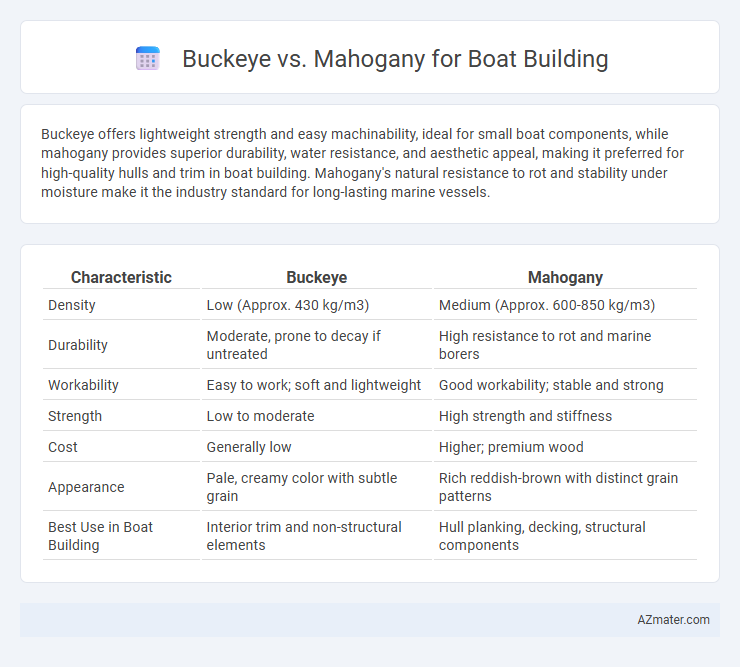Buckeye offers lightweight strength and easy machinability, ideal for small boat components, while mahogany provides superior durability, water resistance, and aesthetic appeal, making it preferred for high-quality hulls and trim in boat building. Mahogany's natural resistance to rot and stability under moisture make it the industry standard for long-lasting marine vessels.
Table of Comparison
| Characteristic | Buckeye | Mahogany |
|---|---|---|
| Density | Low (Approx. 430 kg/m3) | Medium (Approx. 600-850 kg/m3) |
| Durability | Moderate, prone to decay if untreated | High resistance to rot and marine borers |
| Workability | Easy to work; soft and lightweight | Good workability; stable and strong |
| Strength | Low to moderate | High strength and stiffness |
| Cost | Generally low | Higher; premium wood |
| Appearance | Pale, creamy color with subtle grain | Rich reddish-brown with distinct grain patterns |
| Best Use in Boat Building | Interior trim and non-structural elements | Hull planking, decking, structural components |
Introduction: Buckeye vs Mahogany in Boat Building
Buckeye and mahogany are two popular wood choices for boat building due to their distinct properties. Buckeye offers lightweight durability and resistance to rot, making it suitable for small to medium vessels, while mahogany is prized for its rich color, fine grain, and exceptional strength, ideal for high-quality, long-lasting boats. Both woods provide excellent workability, but mahogany is often preferred for luxury yachts, whereas buckeye serves well in more utilitarian or budget-conscious projects.
Wood Properties: Strength and Durability
Buckeye wood offers moderate strength and low durability, making it less suitable for high-stress boat building applications where resistance to rot and water damage is critical. Mahogany, known for its exceptional strength-to-weight ratio and superior natural resistance to rot and insect damage, is widely preferred in boat construction for its longevity and robustness in marine environments. The dense, straight-grained structure of mahogany provides enhanced durability and structural integrity compared to the softer, more porous Buckeye wood.
Workability and Ease of Shaping
Buckeye wood offers excellent workability due to its soft texture, making it easy to cut, shape, and sand with minimal effort, ideal for intricate boat details. Mahogany, while slightly harder, provides smooth and predictable grain, allowing clean cuts and fine finishes during boat building with moderate effort. Both woods respond well to hand tools and power machinery, but Buckeye's lighter density enhances ease of shaping, especially for custom or complex boat components.
Resistance to Moisture and Rot
Buckeye wood offers moderate resistance to moisture but is more prone to rot compared to mahogany, making it less ideal for prolonged exposure to wet environments in boat building. Mahogany is highly valued for its superior resistance to moisture and natural rot-resistant properties, contributing to greater durability and longevity in marine applications. Selecting mahogany over buckeye enhances the boat's structural integrity and reduces maintenance related to water damage and decay.
Weight Considerations for Boat Design
Buckeye wood is significantly lighter than mahogany, making it a preferred choice for boat builders aiming to reduce overall vessel weight and improve fuel efficiency. Mahogany, although heavier, offers superior strength and durability, which benefits structural integrity and longevity in marine environments. Balancing weight considerations, builders often select buckeye for lightweight components and mahogany for load-bearing areas to optimize boat performance and stability.
Aesthetic Appeal and Grain Patterns
Buckeye wood offers a light, creamy hue with subtle, wavy grain patterns that create a soft, natural look ideal for boats seeking a classic, understated aesthetic. Mahogany boasts rich, deep reddish-brown tones with pronounced, interlocking grain that adds sophistication and warmth, enhancing the visual depth of boat interiors and exteriors. The choice between Buckeye and Mahogany in boat building hinges on the desired aesthetic impact, with Buckeye providing a lighter, smoother appearance and Mahogany delivering bold, luxurious grain patterns.
Cost Comparison and Availability
Buckeye wood offers a more budget-friendly option for boat building, typically costing less than mahogany due to its faster growth and wider availability in North America. Mahogany, prized for its durability and rich aesthetic, commands a higher price and is often sourced from tropical regions, making it less accessible and more costly. Availability of Buckeye is higher in local markets, reducing shipping costs and lead times, while mahogany's limited supply can drive prices up, impacting overall project budgets significantly.
Sustainability and Environmental Impact
Buckeye wood, primarily sourced from Ohio, offers moderate sustainability due to its fast growth rate and local availability, reducing transportation emissions, while mahogany, often harvested from tropical rainforests, raises environmental concerns related to deforestation and biodiversity loss. The carbon footprint of boat building with buckeye is generally lower, aligning with eco-friendly practices through sustainable forestry certifications like FSC. Selecting buckeye promotes responsible resource management and helps minimize ecological impact compared to mahogany, which faces stricter regulations and increasing demand for sustainable alternatives.
Maintenance Requirements and Longevity
Buckeye wood offers moderate maintenance needs due to its softer texture, requiring regular sealing and protection against moisture to prevent decay in boat building. Mahogany, prized for its natural resistance to rot and insect damage, demands less frequent maintenance while providing superior longevity and durability in marine environments. The dense, oily composition of mahogany significantly extends the lifespan of boats compared to buckeye, making it the preferred choice for long-term structural integrity.
Best Uses: Choosing the Right Wood for Your Boat
Buckeye offers excellent workability and is lightweight, making it ideal for small boats and intricate joinery where ease of shaping is crucial. Mahogany boasts superior durability and natural resistance to rot and marine borers, making it the preferred choice for hulls and structural components exposed to harsh marine environments. Selecting the right wood depends on balancing Buckeye's ease of use with Mahogany's long-term resilience for the specific demands of your boat.

Infographic: Buckeye vs Mahogany for Boat Building
 azmater.com
azmater.com